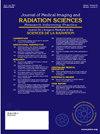影响x线摄影高级从业人员解释乳房x线照片效果的因素
IF 1.3
Q3 RADIOLOGY, NUCLEAR MEDICINE & MEDICAL IMAGING
Journal of Medical Imaging and Radiation Sciences
Pub Date : 2025-04-16
DOI:10.1016/j.jmir.2025.101889
引用次数: 0
摘要
目的在英国(UK)放射学高级从业人员(RAPs)报告乳房x线照片,然而与其他阅读乳房x线照片的专业分组不同,没有数据描述影响阅读性能的因素。这项初步研究探讨了经验、思维定势、对rap所遇到的先验图像的获取等因素是否会影响他们的表现。方法评估15种RAPs对60例已知读数的乳腺x线检查结果的解读能力。这60例中有20例患有癌症,而其余的病例是正常或良性的。为每个RAP建立敏感性、特异性、病变敏感性、受试者工作特征(ROC)和自由反应工作特征(AFROC)值,并使用Student-T和Mann - Whitney检验确定对准确性有显著影响的具体特征。结果在ROC值方面,经验小于10年的阅读者(0.93)比经验大于10年的阅读者(0.84)有更高的值(p = 0.0042);每周阅读量超过100例(0.93)的人,每周阅读量少于100例(0.87)的人(p = 0.0358);相信情绪心态会影响图像解读的人(0.91),相信情绪心态会影响图像解读的人(0.84)(p = 0.0272)。与偶尔依赖先前预测的读者(0.89)相比,一贯依赖[先前成像]的读者(0.94)的ROC值同样较高(p = 0.0231)。结论本初步工作提示,在乳房x线检查中,可能存在影响RAPs诊断效能的因素。这些来自小样本的早期结果表明,需要进一步的探索来优化RAP报告。本文章由计算机程序翻译,如有差异,请以英文原文为准。
Factors that impact upon interpretation efficacy of radiography advanced practitioners who interpret mammograms
Objectives
In the United Kingdom (UK) Radiography advanced practitioners (RAPs) report mammographic images, however unlike other professional groupings who read mammograms, no data are available describing factors that impact reading performance. This preliminary study explores whether or not factors such as experience, mind set, access to prior images encountered by RAPs could impact upon their performance.
Methods
The performance of 15 RAPs interpreting a test set of 60 mammographic cases with known reading outcomes was assessed. Twenty of these 60 cases contained a cancer, whilst the remaining cases were normal or benign. Sensitivity, specificity, lesion sensitivity, receiver operating characteristic (ROC) and free response operating characteristic (AFROC) values were established for each RAP and Student-T and Mann Whitney tests were used to identify specific features that had a significant impact on accuracy.
Results
In terms of ROC values, higher values (p = 0.0042) were seen in those readers who: had less than [10 years experience] (0.93), compared to readers with greater than 10 years of experience (0.84); read greater than [100 cases/week] (0.93), compared to those who read less than 100 cases per week (0.87) (p = 0.0358) as well as readers who believed that emotional mind-set impacted their image interpretation (0.91) compared to those who did not (0.84) (p = 0.0272). Similar higher ROC values were noted in readers who consistently relied on [prior imaging](0.94), compared to those who occasionally relied on prior projections (0.89) (p = 0.0231).
Conclusion
This preliminary work suggests that factors may impact upon the diagnostic performance of RAPs when reading mammograms. These early results from a small sample size demonstrate that further explorations are required to optimise RAP reporting.
求助全文
通过发布文献求助,成功后即可免费获取论文全文。
去求助
来源期刊

Journal of Medical Imaging and Radiation Sciences
RADIOLOGY, NUCLEAR MEDICINE & MEDICAL IMAGING-
CiteScore
2.30
自引率
11.10%
发文量
231
审稿时长
53 days
期刊介绍:
Journal of Medical Imaging and Radiation Sciences is the official peer-reviewed journal of the Canadian Association of Medical Radiation Technologists. This journal is published four times a year and is circulated to approximately 11,000 medical radiation technologists, libraries and radiology departments throughout Canada, the United States and overseas. The Journal publishes articles on recent research, new technology and techniques, professional practices, technologists viewpoints as well as relevant book reviews.
 求助内容:
求助内容: 应助结果提醒方式:
应助结果提醒方式:


